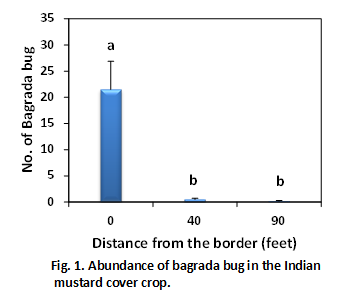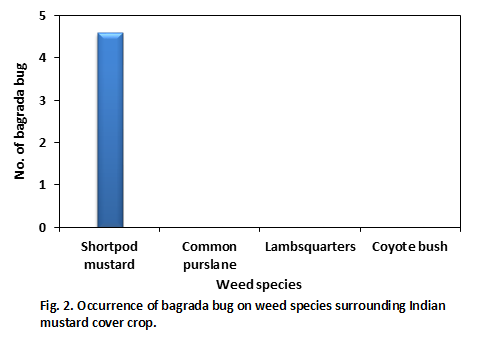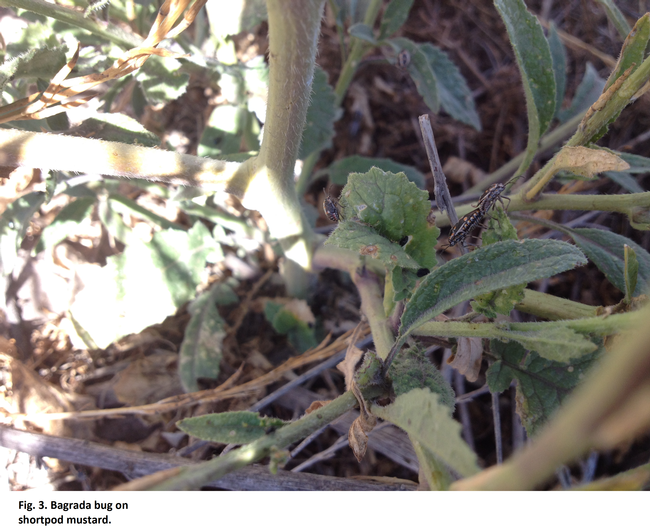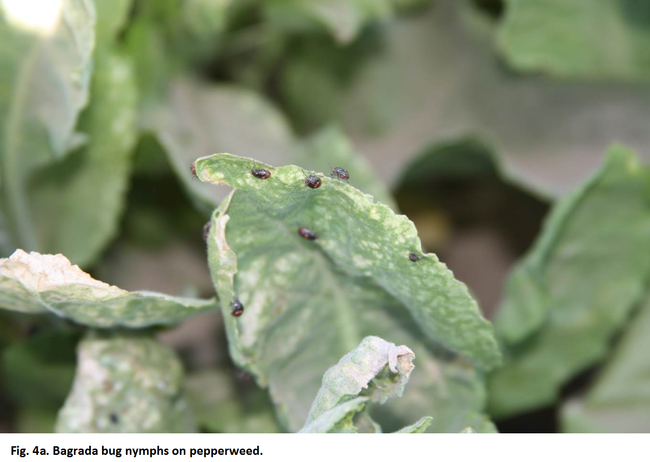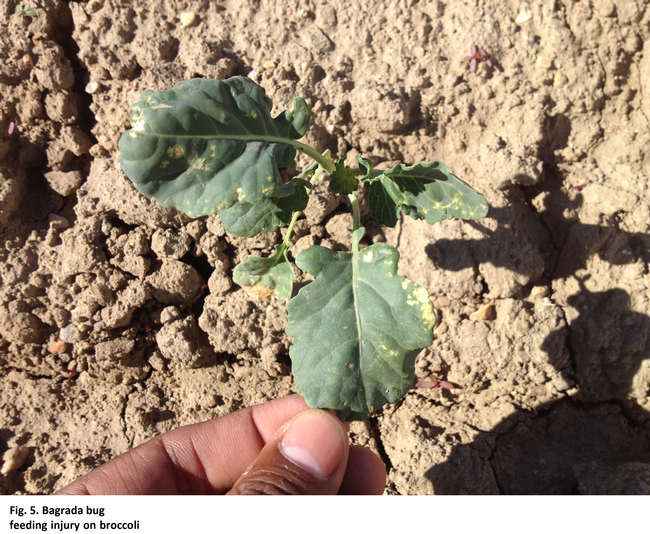Bagrada bug, Bagrada hilaris is now well established in the southern region of the Salinas Valley. This invasive stink bug, if left unmanaged, could become a serious pest of brassica crops. We studied their occurrence on cover crop, a mustard cover crop blend, broccoli and surrounding weed species, and would like to report few observations.
1. Cover crop, mustard
We observed significant populations of bagrada bug on 4-5 week-old mustard cover crop blend (Brassica juncea and Sinapis alba) in San Ardo. Interestingly, the adjacent field was also cover cropped with mustard but was disced few weeks ago. It is likely that the previous adjacent mustard crop might have had a bagrada bugs infestation and they moved to new planting when it was disced. When we walked into mustard stand from the disced field, we noticed that number of bagrada bug numbers declined from the field edge to the interior of the field. To understand better, a border zone (edge of the field), interior zone (90 feet into the field), and intermediate zone (between border and interior zones) were designated. Within each zone, six spots (~ 5.6 feet) were randomly selected and number of bagrada bugs was quantified after spending two minutes per spot. Similarly, two weed species and one native shrub surrounding the mustard field were randomly selected and number of bagrada bugs on them was counted after spending about one minute per plant.
Bagrada bugs tend to be more abundant on the edge of field than interior zones of the field (Fig. 1). It seems that bugs settled on the border plants of the field rather aggressively moving into the field. All life stages were detected. Most of the adults were in the mating position (connected by the rear ends) but very mobile. The adults tend to hide into the soil or under the leaves when we approached the infested plants.
Among the weed species investigated, bagrada bugs were only found on short pod mustard (Fig. 2 and 3). Other weed species investigated were shortpod mustard (Hirschfeldia incana), common purslane (Portulaca oleracea), lambsquarter (Chenopodium album), and the native shrub coyote bush (Baccharis pilularis). It is interesting to note that shortpod mustard plants were senescing, yet we found bagrada bugs on them.
2. Broccoli
The broccoli field was located in San Ardo adjacent to the Salinas River. The riparian plant community along the river contained stands of perennial pepperweed (Lepidium latifolium) as well as other species. Bagrada bug infestation was severe on pepperweed (Figs. 4a, and b).
Bagrada bug feeding injury symptom on broccoli plants was clearly visible on plants along the edge of the field. Feeding injury symptoms on broccoli include leaf distortion, chlorotic patches along the leaf margin and stunting (Fig. 5). Again, feeding symptoms drastically declined and/or plant vigor improved as we walked few steps (~ 10 feet) into the broccoli field from river side. Both nymphs and adults of bagrada bug were active along the edge of the field.
These preliminary observations indicate that some plants in the mustard family are highly attractive to bagrada bug. Shortpod mustard is a common summer-growing species that is commonly found on roadsides, in vineyards and in rangeland. Perennial pepperweed is an invasive plant that is commonly found in the riparian strip along the Salinas River. Both plants provide sufficient food resources for bagrada bug to successfully breed. After the onset of the winter rains, other mustard family weed species such as field mustard (Brassica rapa), black mustard (B. nigra), London rocket (Sisymbrium irio) and wild radish (Raphanus sativus) will begin their growth cycle. These plants are very common along roadsides and in ditches and may also provide over wintering habitat for bagrada bug.
